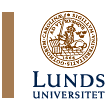

|
Panel No. 2Panel Title: Language in South Asian Literature and CinemaConvenor: Dr. Theo Damsteegt, University of Leiden, the Netherlands Wednesday 7 July, 8–12 & 13–17 Panel Abstract: Papers are to analyse the way language is used in modern literary texts and films in South Asian languages (including English), and the literary or cinematographic effect of that usage. They may, to mention just a few examples, analyse the effect of the use of metaphors or other figurative language; or the effect of dialogue (e.g. viewed from speech act theory), of various ways of representing speech and thought, of 'compound verbs', or of sociolinguistic features. Papers may discuss a single text or film, or compare different texts, or compare films with the literary text they are based on. Read
the convenor’s panel report after the conference
Papers accepted for presentation in the panel:Paper Giver 1: Zdravka Matisic, Filozofski Fakultet, Zagreb, Yugoslavia Paper 1 Title: Hindi literature and its language expressions Paper Abstract: The authors of histories of Hindi literature include without any restriction the works written in Braj and Avadhi as well as the works written in any mixture of Western and Eastern Hindi boliy_n. Most of them include also the old Rajasthani, Pingal and Dingal works, some the Maithili poet Vidyapati too. Rajasthani and Maithili are recognized as full fledged literary languages by Sahitya Academy; recently Maithili was recommended by the Prime Minister of India to be recognized even as one of the official languages of India and accordingly included in the Indian Constitution VIII Schedule. Can we in such a situation include works written in all the above mentioned idioms in the history of Hindi literature or not? The paper tries to answer this question taking into consideration the complex criteria pertaining to the language identity sphere. Paper Giver 2: Janet Kamphorst, Leiden, The Netherlands Paper 2 Title: Battle language: The martial imagery and purpose of Rajasthani heroic poetry Paper Abstract: In Rajasthani heroic-epic
genres, violence and death are presented as festive occasions, events
to rejoice in. The poets drew on images of war, death, religious
sacrifice and wedding rituals, that together constitute a celebratory
“aesthetics of violence”. The proposed paper is a study
of the symbolic meaning and warlike purpose of heroic compositions
in the poetic language of medieval Rajasthan, Dingal. By looking
at martial, religious and marital metaphors of war, we will try
to see whether Dingal heroic poetry can be thought of as narrative
re-enactments of violence that served to legitimize war. Did the
poets of Rajasthan, like traditional poets elsewhere in the world,
versify battle to mask the violent realities of war and thus create
“fictions of concealment”? Paper Giver 3: Robert van de Walle, Leiden, The Netherlands Paper 3 Title: Shyama-Svapna: Rhyming prose in a nineteenth-century Hindi novel Paper Abstract: The novel Shyama-Svapna
(1885, published 1888) by Thakur Jagmohan Singh (1857-1899) is hardly
known outside India despite its strikingly original characteristics.
It is the story of a man who has a vivid dream in which two star-crossed
lovers, the Brahmin girl Shyama and the Kshatriya Shyamsundar, meet
each other repeatedly in secret but realize they will never be able
to marry because of their different castes. The story of Shyama
is surrounded by many amazing events like the apparitions of gods,
a train journey over sea and various magical feats. Paper Giver 4: Mariola Offredi, Department of Eurasian Studies, University of Venice, Italy Paper 4 Title: The composition technique of Dhumil’s poetry Paper Abstract: Dhumil (Sudama Pandey “Dhumil”, 1936-1975) is a rebel poet, as emerges not only from the themes of his poems, but also from the composition technique with which he constructs his images. He is capable of producing “attractive” images, as some unpublished fragments of his earliest work demonstrate. However, in the poems from the collection Sansad se sarak tak (From Parliament to the Street, 1972, 2nd edn. 1975) he uses a “visionary” or hallucinatory method to create provocative images. This provocative vein runs through the whole poem, because one image does not move seamlessly to the next as it does in Muktibodh’s poetry. In the latter case, an image is built up through subsequent lines, or appears in different form in the same poem or in others; sometimes it is condensed into a symbol (and often a personal one). Dhumil’s poetry, on the other hand, is characterised by an accumulation of images, the purposely created emotional chaos stimulating the reader at a pre-rational level. However, Dhumil’s images are not abstract; instead, they are endowed with a unique concreteness typical of hallucinations. Paper Giver 5: Theo Damsteegt, Dept. of South and Central Asian Languages and Cultures, Univ. of Leiden, The Netherlands Paper 5 Title: The imperfective and continuous past in modern Hindi fiction Paper Abstract: The past tense most
commonly used for telling narratives in Hindi is the “aorist”,
which consists of the past participle alone: vah gaya “he
went”. It basically presents actions as completed and as successive
parts of a story. Two past forms not built on the past participle
are the “continuous past” (vah ja raha tha “he
was going”), which is commonly explained as expressing an
action in progress during a limited time in the past, and the “imperfective
past” (vah jata tha), which is taken to indicate a habitual
action or state in the past. Paper Giver 6: Jeroen Nieuwland, Leiden, The Netherlands Paper 6 Title: Language as an alienating factor in Hindi and Indo-English literature Paper Abstract: Sociology generates
the majority of alienation studies. However, interesting perspectives
can be reached when considering alienation as a literary phenomenon.
Below, different instances of language as an alienating factor will
be discussed. The present observations are adapted from my MA thesis
‘Crossing Borders: Alienation of the Indian Immigrant in Hindi
and Indo-English Fiction’. Assertions will be supported with
excerpts and examples from a range of Hindi and Indo-English texts
(mainly short stories). Paper Giver 7: Claudia Preckel, Seminar für Orientalistik und Indologie, Ruhr-University, Bochum, Germany Paper 7 Title: Giving terror a name- linguistic implications of Bollywood's portrayal of Islam Paper Abstract: Since the new millennium,
several films have appeared on screen in which Islamic terrorism
and jihad in Kashmir are portrayed (e.g. "Fiza," Mission
Kashmir" or "Refugee"). One central message of these
films seems to be that Indian Islam is a good Islam, whereas the
"bad" Islam is sponsored from outside, especially from
the Arab countries, but also from the ethnic group of the Pashtoons.
This paper tries to analyse, how language is used to underline this
message. For example, it can be seen that the terrorists' language
contains many words of Arabic origin, while they are also found
to use lots of Arabic expressions and proverbs, for example, regarding
the duties of a "true Muslim." Paper Giver 8: Guzel V.Strelkova, Institute of Asian and African Studies, Moscow State University, Russia Paper 8 Title: A proper name as a characteristic of a hero Paper Abstract: In this paper, based
on some modern Hindi novels (starting with heroines of Jayashankar
Prasaad and Jainendra Kumar, continuing with heroes of Ajney, Bhisham
Sahni, Ilachandra Joshi, Krishna Baldev Vaid, Mannu Bhandari, Ganga
Prasad Vimal, Mohan Rekesh and Alakaa Saraavagi), I would like to
discuss the proper names of heroes in order to find out what possibilities
there are for a better understanding and explanation of a hero’s
character, and how a hero’s name is linked to his self-identity.
I will try to show how new tendencies of choosing a hero’s
name are strongly linked with a “cultural memory” and
a traditional attitude. The problem can be interpreted from a historical
point of view, and with the help of some additional aspects (correlation
of an author and a hero, narration and a narrator, pseudonym, localization
etc.). Paper Giver 9: Suman Ghosh, Dept. of Comparative Literature, Jadavpur University, India Paper 9 Title: English in post-colonial India, Case studies from Satyajit Ray’s cinema Paper Abstract: The Indian subcontinent
has had a complex relationship with the English language for over
three centuries. Much like the initial trade encounters of Indian
people with the English themselves, the relationship between Indian
languages and English began as one of give and take. Later, when
the Crown took over the reins, English became the new ‘official’
language and younger Indians received English education to become
India’s first generation of bureaucrats. Thus English was
firmly rooted as the language of power in the subcontinent. Paper Giver 10: Alain Désoulières, Inalco/Crescic, Paris, France Paper 10 Title: Language in historical fiction; the case of Anarkali Paper Abstract: Language and style
have always been important issues in the writing of drama, and more
so when dramas were written not only for the stage but also for
the screen. Artistic choices and commercial aims always require
peculiar techniques in writing as well as precise linguistic and
stylistic choices, to fit the mood of the drama. This is naturally
true of Urdu drama and cinema, considering the fact that Urdu stage
drama was for long an important source of inspiration for Hindi
and Urdu cinema. Paper Giver 11: Hakim Arif, Dept. of Linguistics and Tazin Aziz Choudhury, Dept. of English, Dhaka University, Bangladesh Paper 11 Title: Vulgarity in the titles of recent Bengali commercial films of Bangladesh: An onomastic study Paper Abstract: Recently Bengali films are facing an identity crisis because of their deviation from contemporary culture and present life-style of Bengali people. In terms of theme, title, and quality, a sharp division between commercial and art film. Currently commercial films dominate in the film industry of Bangladesh in all respect and illustrate this kind of ‘cultural emptiness’, especially in their ‘titles’-the icon that manifest their existence in the real world. Presently the maximum number of Bangladeshi commercial films have such ‘vulgarities’ that not only fail to attract audiences’ attention but also reflect the moral depravity of their capital investors. Furthermore, these kinds of ‘vulgarities’ highlight the erosion of Bengali cultural values and the instability of Bengali society, the unhealthy environment of film industry and influence of ‘Bollywood’-the Indian biggest film industry Mumbai city that is famous for exporting commercial films throughout the world. In this paper, we will discuss the history of ‘title’ of Bengali films, the attitude of people regarding this trend of growing vulgar titles, their grammatical interpretation, thematic relevance and a brief description of the vulgar types of title that are presented in present Bangladeshi commercial films. Paper Giver 12: A Salman Al-Azami and Tasleem Shakur, International Centre for Development & Environmental Studies (ICDES), Edge Hill University College, England Paper 12 Title: Sarat Chandra’s Devdas: A comparative analysis of the language of the original Bengali text with two Hindi film versions Paper Abstract: Although Sarat Chandra
Chattopadhyay’s original Bengali novel Devdas (the narrative
style of which seems to be inspired by the late Victorian English
novelists) was written as early as the turn of the 20th century,
the urge to adapt it into film seems to be continuing even to the
present time. This study attempts to analyse the Hindi film versions
of Devdas, the earlier one directed by Bimal Roy (a renowned Bengali
director in the 1950s,which provides a more literal translation
of the original Bengali novel) and Sanjay Leela Bhansali's latest
blockbuster (which has a number of deviations from the original
text), and compares the language of the novel with the two film
versions.
Panel report:
|

